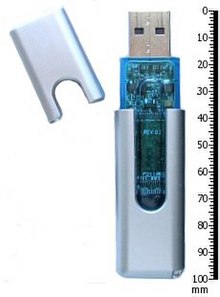USB mass storage device class: Difference between revisions
rv newbie test |
No edit summary |
||
| Line 55: | Line 55: | ||
[[Category:USB|Mass storage device class]] |
[[Category:USB|Mass storage device class]] |
||
[[Category:Computer storage devices]] |
[[Category:Computer storage devices]] |
||
[[sv:UMS]] |
|||
Revision as of 19:54, 4 June 2006
The USB mass storage device class (umass) is a set of computing communications protocols defined by the USB Implementers Forum that run on the Universal Serial Bus. The standard provides an interface to a variety of storage devices.

Some of the devices which are connected to computers via this standard are:
- external magnetic hard drives
- external optical drives, including CD and DVD reader and writer drives
- portable flash memory devices, particularly keydrives
- adapters bridging between standard flash memory cards and a USB connection
- digital cameras
- digital audio players (MP3 players, e.g. iAudio, iPod and Creative Labs MuVo series)
- high-end hardware media players
Operating system support
As of 2004, most current main-stream operating systems include support for USB mass storage devices, although support on older systems is available through patches.
Microsoft's Windows 95 OSR2 and Windows 98 operating systems featured very limited support for USB in general, and no generic USB mass storage driver was produced. This meant that a device-specific driver was needed for each type of USB storage device the installation encountered. This situation was (almost) remediated with the later Windows Me and Windows 2000 products (where a specific driver was required only for very unusual mass storage devices) and essentially removed for the later Windows XP and Windows Server 2003 systems.
There is no native (supplied by Microsoft) support for USB in Windows NT, MS-DOS or earlier versions of Windows, although some several third-party solutions exist for each OS.
Apple Computer's Mac OS supports USB mass storage by means of optional drivers from OS 8.5.1, and OS 9 and OS X support USB mass storage natively.
Support in the Linux kernel began in kernel version 2.4, although 2.2 has been back-patched to support it.
NetBSD supports UMASS storage devices as well since the 1.5 release and up.
Windows Mobile supports most mass storage devices formatted with FAT on devices with USB Host, although devices powered by it typically cannot provide enough power on their own to run hard drives.
The game consoles Xbox 360 and PlayStation 3 support most mass storage devices.
File systems

The USB mass storage as such does not specify which file system shall be used on the device using it; instead, it mainly provides a way of reading out sectors as on any hard disk device. Operating systems are free to format this storage area with any file system they like.
Because of its ubiquity and relative simplicity, the most common file system on embedded devices such as keydrives, cameras or MP3 players is the FAT file system with support for long names. Large USB-based hard disks may come formatted with NTFS, which is much less supported outside Microsoft Windows, but a keydrive or any other device which is primarily intended for storage may be formatted using for example HFS Plus on an Apple Macintosh, or Ext2 under Linux.
On cameras and similar gadget which need to access the filesystem on their own, FAT is typically preferred by the device manufacturers. Altering the filesystem in this case is generally a bad idea: the device will probably stop working.
Note that disk file systems were not devised with flash memory in mind. Flash-specific concerns like limited number of writes per cell can be affected by a write-heavy file system while disk concepts fragmentation or contiguity are not problems in flash because they impose no appreciable I/O delays.
Complications of the mass-storage device class
The mass storage interface is an attractive option for many devices, such as cameras and media players, which are nonetheless capable of more functionality than being simple data repositories. By presenting themselves as simple datastores, these devices can leverage the high degree of support for the USB mass-storage device class in current operating systems' USB driver stacks and allow easy read and write access to their internal memories. The downside of doing so is that it prevents the device from easily presenting its actual functional behavior across the USB interface too. For example, the makers of a digital still camera would also like it to implement the USB still-image device class, allowing it to be controlled by image capture software.
Some USB digital cameras feature a switch allowing them to appear either as a mass-storage device or as a still-picture device, but they cannot be both at the same time. It is likely that as development of USB controller chips advances this constraint will cease to be an issue.
External links
- Mass Storage device class specification — on the site of the USB Implementers Forum.
- Bootability specification Mass Storage bootability specification — describes how bootable USB Mass Storage devices should work.
- "USB Mass Storage BOT" is a link that often rots, lately found buried at "USB" -> Developers -> Documents -> Class Specs -> Approved -> Mass Storage -> "Mass Storage Bulk Only 1.0".
- "Microsoft USB Storage FAQ"
